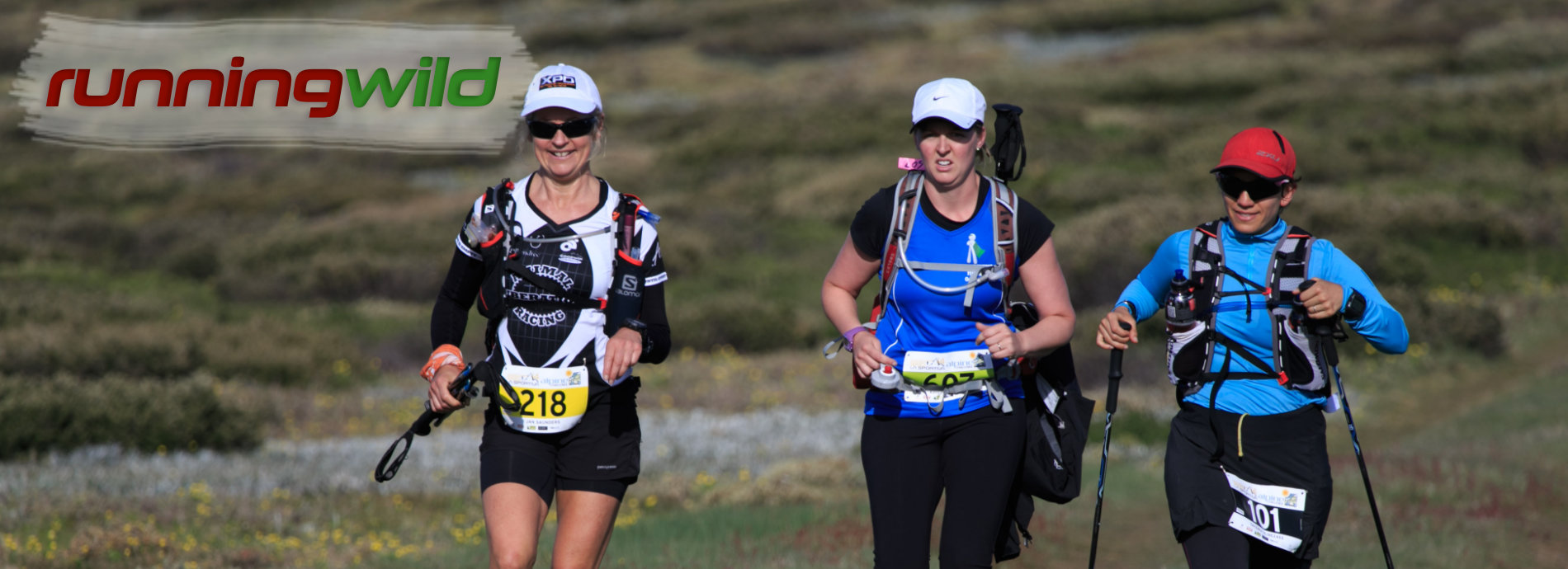But they came, experienced runners, Alpine Challenge virgins, cautious, enthusiastic, respectful of the mountain and the elements, hardened athletes with months of preparation in their legs wanting to tackle the Big One. At the pre race briefing, just about every aspect of the run was covered in an hour long presentation aimed to provide runners with the information that could assist them in surviving and finishing the course. The Alpine Search and Rescue, radio teams and sweeps were introduced and then felling slightly on edge, runners drifted off for that final check of their packs and a restless pre run sleep.
The Mount Bogong SAR team and event personnel then headed off for a night time ascent of the mountain to be prepositioned for the first runners.
As RD, I was wired and couldn’t sleep so at 2 A.M. I was up and about, placing out the final course markers and setting up the start area, at 04:10 A.M. the first runners started drifting down to the start area for the count into the starting yard and then at 04:30 in a mild 15 C they were off into the darkness for the first river crossing and a 1200 m climb up Spione Kopje.
That feeling of something might not go as planned struck me again when, with a fully laden car on the drive into Warby Corner I got a flat tyre, transferring the radio team into the SAR vehicle I set about emptying the Subaru and replacing the tyre (luckily I had the spare repaired the week before), and then headed off to a lightening sky to Warby Corner to set up Checkpoint One.
Just after 6.30 A.M. the cry went up—“Runner Coming” and we looked to see a solitary light on the track down from Spione Kopje—we raced off to greet Matt Cooper and ask him if he could come back in half an hour—he laughed and ran straight through towards Mount Bogong.
For the next two hours we were inundated with a steady stream of runners meeting their support crews who had walked in 6 km with a range of goodies, then, suddenly at 08.30, Team Icarus arrived and left and we were out of business—no runners, no support crews just peace and solitude—it would be nearly five hours until Matt and Gretal made the return to Warby Corner, so we set about putting up radio masts and establishing the camp and catching some sleep.
Radio traffic was interesting, as runners got to Mount Bogong we got reports of 60 km runners being seen on Quartz Ridge, definitely the wrong way and 100 km runners heading up Quartz Ridge then, realising their mistake turning back and heading down via Ropers to ensure that they did the correct course, adding an extra 20 km to their run in some cases.
The wind started to pick up and clouds started to gather and we said “the weather —it’s a brewing—let’s batten this place down”—not knowing what was in store for us later that night.
Having recently received my amateur radio operators licence I was now able to go mobile and still stay in contact with Warby Corner, Mt Bogong and through them Bogong Village—so with that knowledge Michael and I headed off on a 2 km jog carrying 8 litres of water and some bladders to set up the checkpoint at Ropers Hut, an area that I would get to know intimately as I checked runners in and out over the next 10 hours. Michael and I set up a checkpoint and then headed down to the creek to get another 10 litres of water for runners slogging up Duane Spur in the heat.
The runners materialised but the heat didn’t, instead we set about cutting wood for the fire and getting it blazing so that as darkness fell and along with it, the temperatures, the runners would have a warm cosy shelter to pop into and take on more food and water.
In our warm sheltered hut with its solid walls and tin roof we would have been oblivious to the gathering storm if not for our radio. Calls from Mount Bogong talked of poor visibility and strong winds, of runners withdrawing at Mountain Creek and the need to close the Quartz Ridge descent on safety grounds due to the possibility of runners stumbling or getting blown off the cliff edge—this wasn’t just coming from the support team but from a survey of runners as they came through the checkpoint. We were entering the dark zone—where things invariably started to go from bad to worse.
As reports kept coming through Alpine SAR on Mount Bogong, we worked through a number of scenarios which included cancelling the run, closing Quartz Ridge and sending runners back via Duane and T-Spur, holding them at Mountain Creek and seeing what the weather did overnight. We opted to send runners back out along T- and Duane Spurs to Warby Corner and to pull any runners that hadn’t made the Ropers Hut cut off, sending them off on a 116 km course.
Rain was now lashing the hut with increasing frequency and the mist descended at Ropers limiting visibility, glow sticks and a strobe light guided the last two runners to the hut and then we closed the checkpoint and walked with bowed heads towards Warby Corner. The ferocity of the wind was amazing—we had estimated it to be in the vicinity of 60 km/h but upon checking with the Met Bureau found it to be well over 80 km/hour and more likely in excess of 100 km/h at Warby Corner and Mt Bogong Summit.
The two Karens called up their support crew and after checking in with James in the radio tent, I headed to bed after 24 hours on the go.
Awakened after only about 10 minutes sleep by a crash and a yell, I emerged to find James a bit battered but without his tent—it was gone—picked up by the wind and smashed into 4 pieces, the radio mast had crashed to the ground, the SAR tent flattened and our radios and stores exposed to the elements. A frantic burst of activity secured everything and we went back to our tents and tried to understand what had happened.
Calling SAR at Bogong Village we found that not only had our control point been flattened by the winds but so had Mount Bogong. Things were serious—our radio net and ability to mount search and rescue missions were both compromised and that had immediate safety implications.
A decision was made to hold all the runners at Mountain Creek, turn around those on the Staircase approaching Mount Bogong, hold the sweep and cancel the race once Gill Fowler and Dan Beard the two lead runners emerged from the woods and got to Warby. Calls and texts were sent to support crews, mobilising them and getting them into position to pick up their runners and take them back to Bogong Village. Finally at 4 A.M. a plaintive call outside my tent told me Gill had arrived—inviting her in, I asked her what it was like—“frightening” she said. She had been heading up Duane Spur with the sounds of trees crashing to the ground, the wind chill would have been terrible, ice had formed on the tent and the temperature had dropped to -2.2 C.
Silently relieved that the event had been placed on hold, pending a reassessment in the daylight she headed off to meet her support crew whilst I waited another hour for big Dan. Ever smiling Dan squeezed into the tent and started to strip off and put on more clothes, unfortunately in the process he had to remove his runners which he had been wearing for over 24 hours! He was also pleased that we were suspending the event and would reassess the situation in the morning.
However, the issue with restarting the event from Langfords Gap, in high winds was that it would mean runners would have to traverse the Fainters Fire Trail—an area notorious for tree falls, following the fires of 2010.
As RD the responsibility for the safety of the runners was mine and I reluctantly decided that it wasn’t worth the risk to runners, sweeps, rescue personnel or the reputation of the run and our relationship with Parks Victoria—all factors that had to be weighed up. I confirmed my decision with Parks Victoria who also agreed that the risk to runners, sweeps and SAR personnel was too great.
Mount Bogong had blown us off the mountain but we had all learnt something in the process:
The runners—that there were good reasons behind the mandatory safety gear list. That Bogong and the High Plains had given us just a taste of what they could turn on and how even the best runners wouldn’t have had the equipment to endure those conditions with extended periods of rain thrown in especially when combined with sub zero temperatures and driving winds.
Alpine SAR—that we needed to have better communication between SAR personnel and race officials in the event of an emergency, and that we needed to build in more redundancy into our communications systems.
The RD—to trust the people on the spot, to be able to think and plan coherently and clearly and make decisions while everything was falling apart, on a minimum of sleep. To be located at the heart of the event—especially at night.
While all this was going on records were being trashed in the 100 km run with Matt Cooper setting a blistering time of 12.31 (course record), although when you read his blog he talks about stopping for rests to take in the scenery, he was hotly pursued by rising star, Wes Dose in 13.22 whilst in the women’s 100 km Gretel Fortmann finished in 15.48 (course record). And they all looked fresh as daisies at the finish.
To the runners, event crew, volunteers, support personnel, Bogong Village Staff and Parks Victoria—I say thank you—you were all wonderful and helped make a daunting challenge into something that built strong memories and firm friendships.
Mount Bogong had better watch out because there are a lot of people with unfinished business who will be back in November 2014.
For this event—there were no DNF’s recorded only “Withdrawn” and “Course Closed” to do any less would be to pay a disservice to the difficulty of the run and the tremendous efforts put in by all who participated.
For some great photos taken by Rachael Baggallay on Mount Bogong, click on the link below:
http://www.flickr.com/photos/94121960@N03/sets/72157633022137326/
and for some of my photos at Warby Corner and Ropers Hut click below:
http://www.flickr.com/photos/94380929@N05/
From 2014, the Alpine Challenge moves to a new date in late November in order to avoid the bushfire season.




